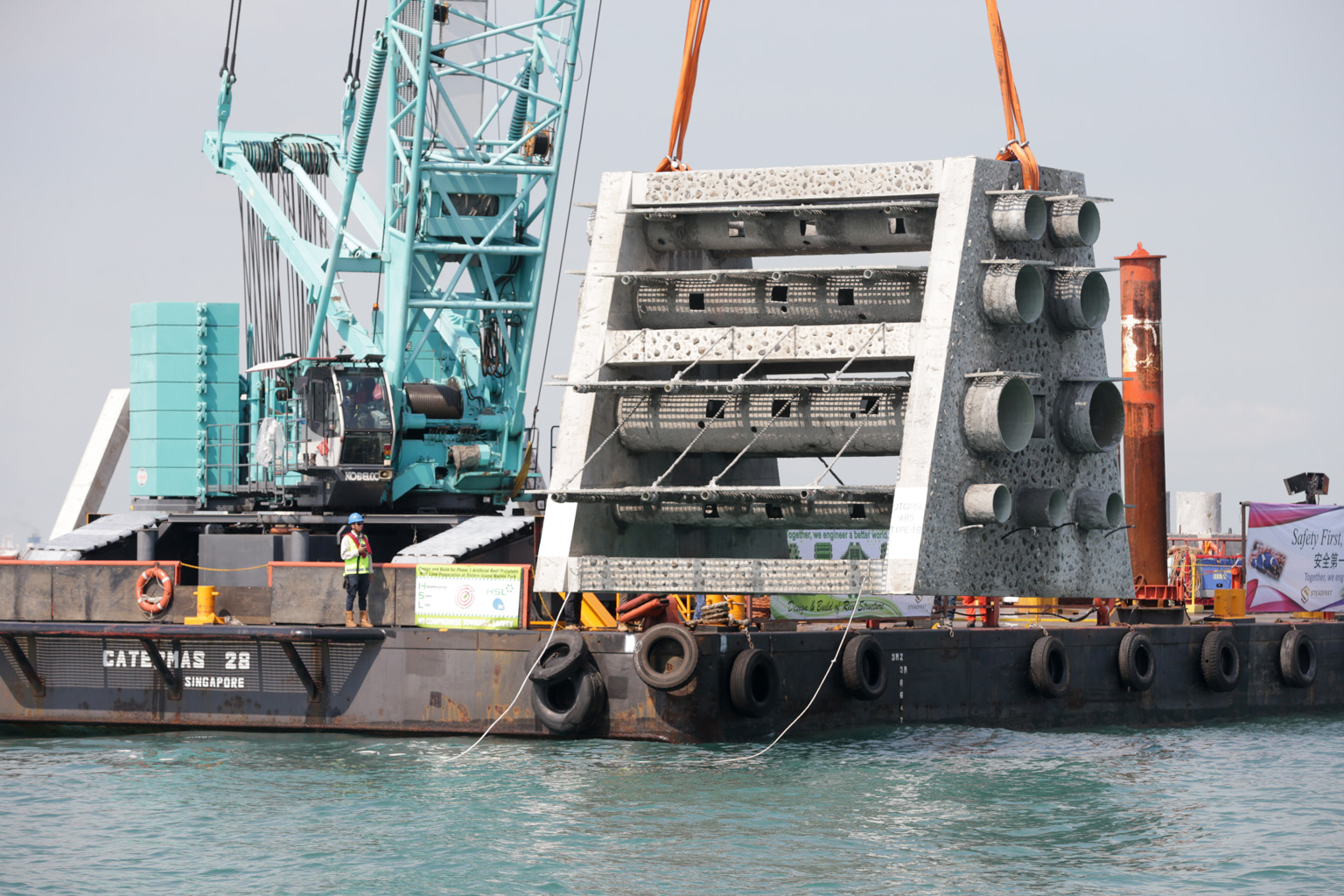Singapore's largest reef structure installed
Man-made reef in waters off Small Sister's Island will boost marine conservation efforts
Sign up now: Get ST's newsletters delivered to your inbox

Singapore's largest man-made reef structure being installed in the waters off Small Sister's Island yesterday. This 10m-high structure will form a three-storey ''terraced house'' upon which corals may take root and grow, and double as a new home for other forms of marine life, said Speaker of Parliament Tan Chuan-Jin, who witnessed the structure's installation.
ST PHOTO: ONG WEE JIN
Cheryl Teh
Follow topic:
In an effort to preserve Singapore's marine biodiversity, the Republic's largest man-made reef structure to date was installed yesterday in the waters off Small Sister's Island.
It is part of an installation that comprises eight reef structures in total, all fabricated off-site. They will be fully installed by the end of the year.
When the corals grow, these reef structures are expected to contribute some 1,000 sq m of additional reef substrate to the Sisters' Islands Marine Park by 2030.
The installation constitutes an important expansion of conservation efforts in Singapore's Southern Islands, of which the Sisters' Islands are a part of, and is part of the "Grow-a-Reef Garden" project, a collaboration between JTC and the National Parks Board (NParks).
Announced in May, the project was proposed as part of efforts to protect the coral reefs around Singapore and enhance marine biodiversity in the island's surrounding waters.
Each of the 10m-high structures will form a three-storey "terraced house" upon which corals may take root and grow, and double as a new home for other forms of marine life to live in and flourish, said Speaker of Parliament Tan Chuan-Jin, who witnessed the installation of the first structure yesterday.
Representatives from JTC and NParks, members of the Friends of Marine Park community, donor companies, industry guests, as well as local marine research and interest groups also attended the event.
The structures will sit in the 40ha Sisters' Islands Marine Park, which is south of Sentosa and about a 45-minute boat ride from Marina South Pier. They are made of materials such as concrete, fibreglass pipes, steel and rocks recycled from JTC projects. Each structure has nooks and crannies within which fish species and other forms of sea life may find shelter and thrive.
11
Number of donor companies which have pledged support to the "Grow-a-Reef Garden" Initiative.
$290k
Total amount given by the firms.
Eleven donor companies have pledged support to the initiative, contributing a total of $290,000, with each giving sums ranging from $5,000 to $100,000.
Besides helping to pay for the implementation of the reef structure project, the money will fund monitoring programmes, research projects, education and public outreach activities.
"We are heartened by the generous support from our industry partners on the Grow-a-Reef Garden Initiative," said Mr Ng Lang, chief executive of JTC. "We hope that more from the industry and community will join us to create a more sustainable environment."

The reef structures are intended to transform bare seabed into a flourishing marine ecosystem, allowing corals to take root, and in turn attract fish and other marine life.
"The project... will be significant in supporting marine habitat enhancement and reef restoration efforts," said Mr Tan. "There is no silver bullet to overcome our environmental challenges. What we need is a range of multi-disciplinary solutions involving expertise from different parties."

Mr Tan said long-term conservation and management of Singapore's coastal and marine environment are essential for Singapore's future. "This is particularly timely as the International Coral Reef Initiative has designated this year as the International Year of the Reef, and this project will help our efforts in enhancing Singapore's coral reef ecosystems," he added.
Restoring reef substrate is an essential step to recover damaged reefs that have become unsuitable for coral populations to settle.
After the reef structures are installed, they will be monitored through research initiatives coordinated by NParks, which will get various marine interest groups involved as well.
NParks chief executive Kenneth Er said that the project will facilitate research initiatives that will go a long way in supporting conservation efforts in other marine areas of Singapore.
"Our marine biodiversity is our common natural heritage, and we are glad to see partners stepping forward to conserve it," he added.
Singapore has lost approximately 60 per cent of its reefs to land reclamation over the years. Local reefs are also recovering from a bout of bleaching in 2016, which was caused by a prolonged period of high sea surface temperatures.
It was estimated that about 15 per cent to 20 per cent of corals in Singapore's waters died because of the bleaching.
In a statement, NParks said the installation complements efforts to expand the scope and scale of other marine habitat restoration programmes. For instance, the NParks in-situ coral nursery will also be established in the Reef Garden.
Rare corals that may be threatened by coral bleaching can also be moved to this controlled environment, in an attempt to ensure their survival.
"We are heartened by the efforts of the business community in sharing our goals to conserve marine biodiversity and encourage vibrancy at the Sisters' Islands Marine Park," said Mr Stephen Beng, chairman of the Friends of Marine Park community. "We are hopeful about the enhancement benefits this new reef habitat will bring to life in our waters."
Correction note: In an earlier version of the article, one mention of Sisters' Islands Marine Park was misspelt. We are sorry for the error.

